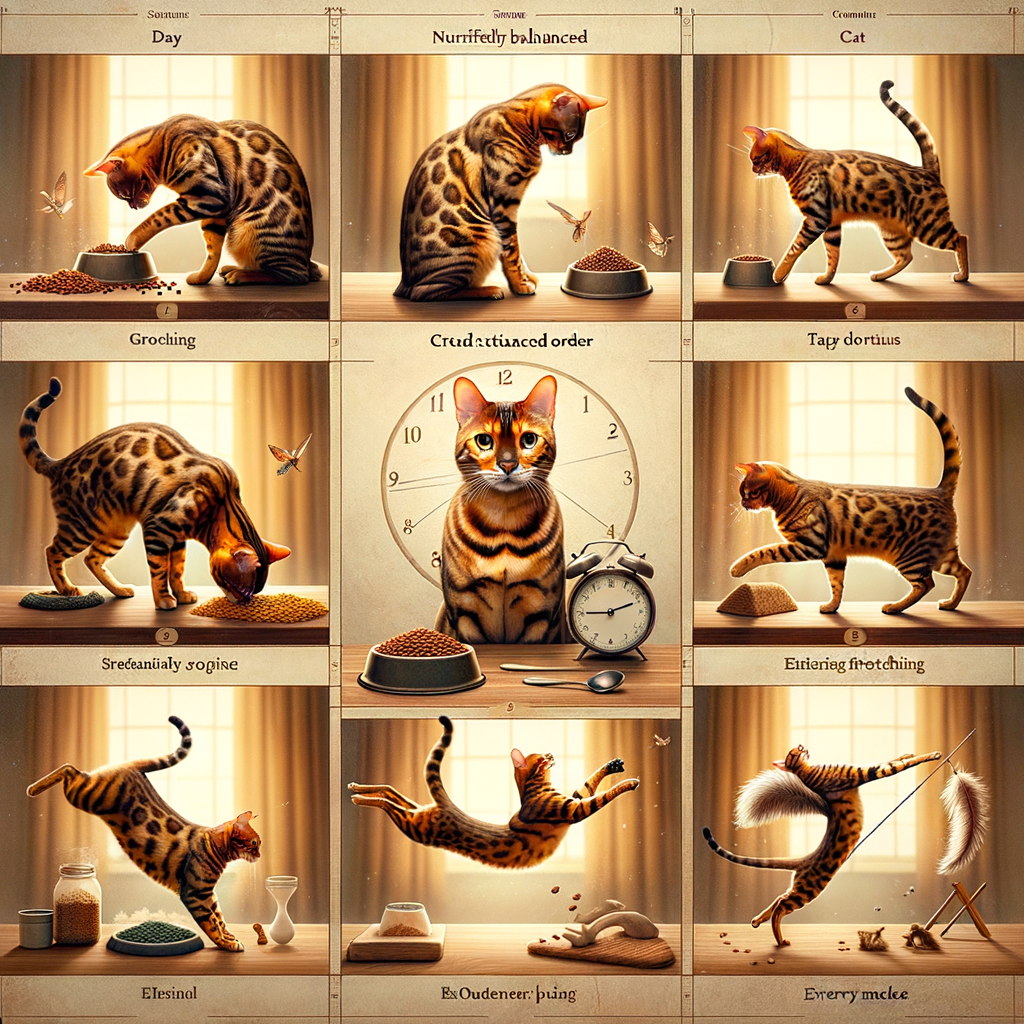
Introduction to Bengal Cat Routine
-
The Importance of Routine for Bengal Cats
Bengal cats thrive on routine. A consistent schedule helps them feel safe and secure. When they know what to expect, they are less likely to feel stressed. This can lead to a happier and healthier cat.
Routines help Bengal cats manage their energy levels. These cats are very active and need regular playtime. A set routine ensures they get enough exercise and mental stimulation.
Feeding at the same times each day also helps. It keeps their digestive system regular and prevents overeating. A routine can even help with litter box habits, making it easier to keep your home clean.
-
Overview of a Typical Bengal Cat Daily Schedule
A typical day for a Bengal cat might look like this:
Time Activity 7:00 AM Breakfast 8:00 AM Morning Playtime 10:00 AM Nap Time 12:00 PM Lunch 1:00 PM Afternoon Playtime 3:00 PM Nap Time 6:00 PM Dinner 7:00 PM Evening Playtime 9:00 PM Quiet Time and Bed This schedule includes regular meals, playtimes, and naps. It helps keep your Bengal cat happy and healthy. You may need to adjust the schedule to fit your cat’s needs.
Bengal Cat Care Tips
Bengal Cat Feeding Routine
- Importance of a consistent feeding scheduleCats thrive on routine, and feeding them at the same times each day helps regulate their metabolism. A regular schedule can also prevent overeating and obesity.
For example, feeding your Bengal cat twice a day, once in the morning and once in the evening, can help maintain their energy levels. Consistency also helps you monitor their eating habits and quickly notice any changes that might indicate health issues.
- Recommended diet for Bengal catsBengal cats need a balanced diet rich in protein. High-quality cat food that lists meat as the first ingredient is ideal. Wet food can be beneficial because it provides hydration, but dry food is also acceptable if it meets nutritional needs.
Here is a table with recommended nutrients for Bengal cats:
Nutrient Recommended Amount Protein 30-40% Fat 15-20% Fiber 3-5% Moisture 70-80% Avoid feeding your Bengal cat human food, as it can be harmful to their health. Consult with your vet to tailor a diet plan specific to your cat’s needs.
Bengal Cat Exercise Needs
- The high energy levels of Bengal catsBengal cats are known for their high energy levels. They are very active and love to play. This means they need a lot of exercise to stay happy and healthy. Without enough activity, they can become bored and may develop bad habits.
-
Exercise routines to keep your Bengal cat healthy
- Interactive toys: Use toys that move or make noise to keep your cat engaged.
- Climbing trees: Bengal cats love to climb. A cat tree can give them a place to jump and climb safely.
- Laser pointers: Many cats enjoy chasing a laser pointer. This can be a fun way to get them moving.
- Playtime: Spend at least 15-20 minutes each day playing with your cat. This helps them burn off energy and strengthens your bond.
| Exercise Type | Benefits |
|---|---|
| Interactive Toys | Keeps them engaged and active |
| Climbing Trees | Provides a safe place to climb and jump |
| Laser Pointers | Encourages running and chasing |
| Playtime | Burns energy and strengthens bond |
Bengal Cat Grooming and Health Maintenance
Bengal Cat Grooming Habits
- How often to groom your Bengal catIt is recommended to brush your Bengal cat at least once a week. Regular grooming helps remove loose fur and reduces shedding. This practice also helps in bonding with your pet.
-
Essential grooming tools for Bengal cats
- Brush: A soft-bristle brush is ideal for removing loose fur.
- Comb: A fine-tooth comb helps detangle any knots.
- Nail Clippers: Regular nail trimming prevents overgrowth and discomfort.
- Ear Cleaner: Use a vet-approved ear cleaner to keep their ears clean.
| Grooming Tool | Purpose |
|---|---|
| Brush | Removes loose fur |
| Comb | Detangles knots |
| Nail Clippers | Trims nails |
| Ear Cleaner | Keeps ears clean |
Bengal Cat Health Maintenance
-
Regular vet check-ups for Bengal cats:
Regular check-ups help catch any health issues early. Your vet will check your cat’s weight, teeth, and overall health. They may also give vaccinations to keep your cat safe from diseases.
-
Common health issues in Bengal cats and how to prevent them:
- Hypertrophic Cardiomyopathy (HCM): This is a heart disease common in Bengal cats. Regular vet visits can help detect it early. Keeping your cat at a healthy weight and feeding them a balanced diet can also help.
- Progressive Retinal Atrophy (PRA): This eye disease can lead to blindness. There is no cure, but regular eye check-ups can help manage it. Make sure your cat gets enough taurine in their diet, as it is essential for eye health.
- Dental Issues: Bengal cats can suffer from gum disease and tooth decay. Brushing your cat’s teeth regularly and providing dental treats can help prevent these problems.
| Health Issue | Prevention Tips |
|---|---|
| Hypertrophic Cardiomyopathy (HCM) | Regular vet check-ups, healthy weight, balanced diet |
| Progressive Retinal Atrophy (PRA) | Regular eye check-ups, taurine-rich diet |
| Dental Issues | Regular teeth brushing, dental treats |
Bengal Cat Behavior Patterns
- Recognizing common Bengal cat behaviors
Bengal cats are known for their playful and energetic nature. They love to climb, jump, and explore their surroundings. You might often find them perched on high shelves or darting around the house. Bengals are also very vocal, using a variety of sounds to communicate with their owners. They might chirp, meow, or even make a sound that resembles a bark.
Another common behavior is their love for water. Unlike many other cats, Bengals enjoy playing with water and might even join you in the shower! They are also very curious and intelligent, often figuring out how to open doors or cabinets.
- How routine can influence Bengal cat behavior
Cats, in general, thrive on routine, and Bengals are no exception. Having a consistent schedule for feeding, playtime, and rest can help your Bengal feel secure and reduce stress.
For example, feeding your Bengal at the same times each day can prevent overeating and help maintain a healthy weight. Regular playtime can help burn off their high energy levels, reducing the likelihood of destructive behaviors. A consistent bedtime routine can also help your Bengal wind down and get a good night’s sleep.
Bengal Cat Training and Playtime Activities
Bengal Cat Training Routine
- Effective training techniques for Bengal cats:
Training Bengal cats can be fun and rewarding. Start with basic commands like “sit” and “stay.” Use treats and positive reinforcement to encourage good behavior. Clicker training is also effective. Always be patient and consistent. - Importance of routine in Bengal cat training:
Bengal cats thrive on routine. Having a set schedule for feeding, playtime, and training helps them feel secure. Consistency in training times helps reinforce good habits. A regular routine reduces stress and makes training more effective.
Bengal Cat Playtime Activities
- Fun and engaging activities for Bengal cats:
- Interactive Toys: Toys like laser pointers, feather wands, and puzzle feeders can keep your Bengal cat engaged for hours.
- Climbing Trees: Bengal cats love to climb. A cat tree or shelves can provide them with the vertical space they crave.
- Water Play: Unlike many cats, Bengals often enjoy playing with water. A shallow water dish or a pet fountain can be a great source of fun.
- Hide and Seek: Hiding treats or toys around the house can stimulate their hunting instincts.
- How playtime contributes to a Bengal cat’s routine:
- Physical Exercise: Playtime helps Bengal cats burn off excess energy, keeping them fit and healthy.
- Mental Stimulation: Engaging activities prevent boredom and reduce the risk of behavioral issues.
- Bonding: Interactive play strengthens the bond between you and your cat, making them feel more secure and loved.
- Routine: Consistent playtime can help establish a daily routine, which is beneficial for their overall behavior and happiness.
The Impact of Routine on a Bengal Cat’s Life
- Summary of the importance of routine for Bengal cats:It helps them feel safe and secure. A consistent schedule for feeding, grooming, and playtime can reduce stress and improve their overall well-being.
-
Key takeaways on Bengal cat care, grooming, behavior, and training:
- Care: Regular vet visits and a balanced diet are essential. Keep their environment clean and provide fresh water daily.
- Grooming: Brush their coat weekly to reduce shedding. Regular nail trimming and dental care are also important.
- Behavior: Bengal cats are active and curious. They need mental stimulation and physical activity to stay happy.
- Training: Use positive reinforcement techniques. Consistent training helps in managing their behavior and strengthens your bond with them.
| Aspect | Importance |
|---|---|
| Routine | Provides security and reduces stress |
| Care | Ensures health and well-being |
| Grooming | Maintains coat and dental health |
| Behavior | Keeps them active and mentally stimulated |
| Training | Improves behavior and strengthens bond |
A well-structured routine is vital for the health and happiness of Bengal cats. By following the tips on care, grooming, behavior, and training, you can ensure your Bengal cat leads a fulfilling and joyful life.






